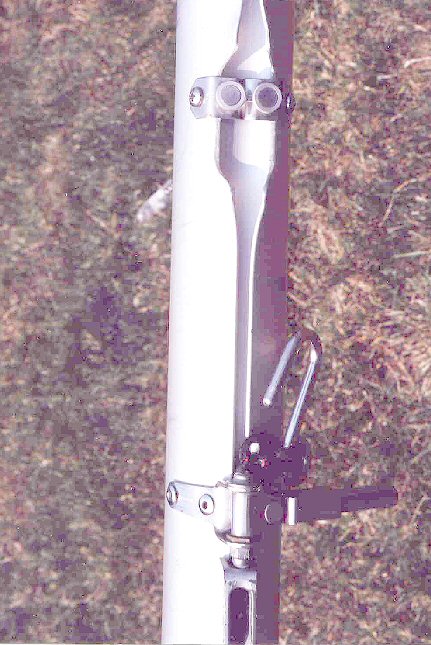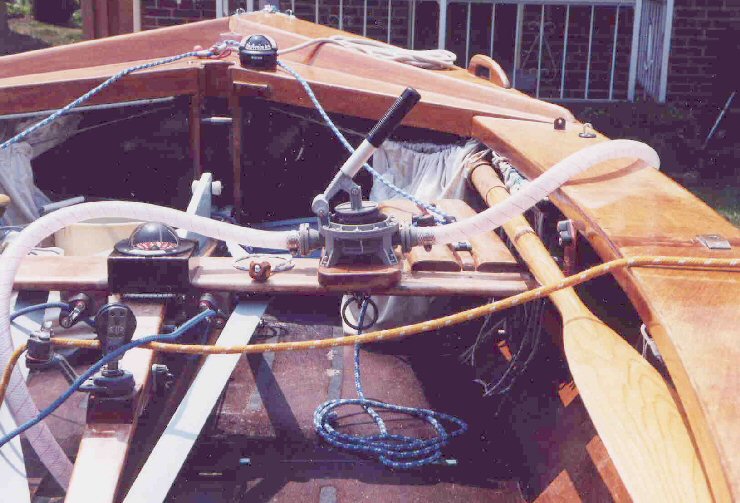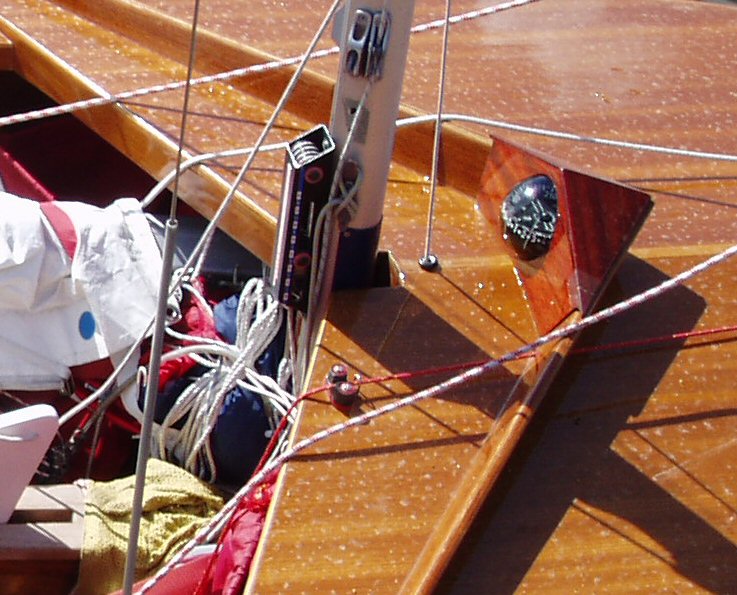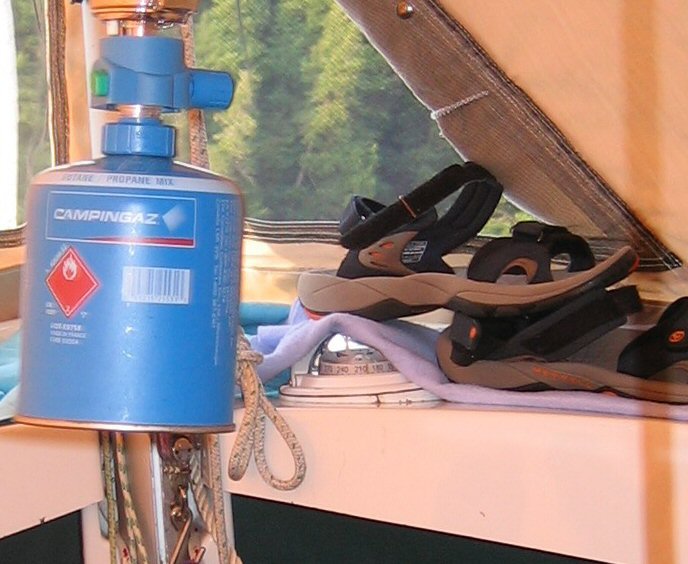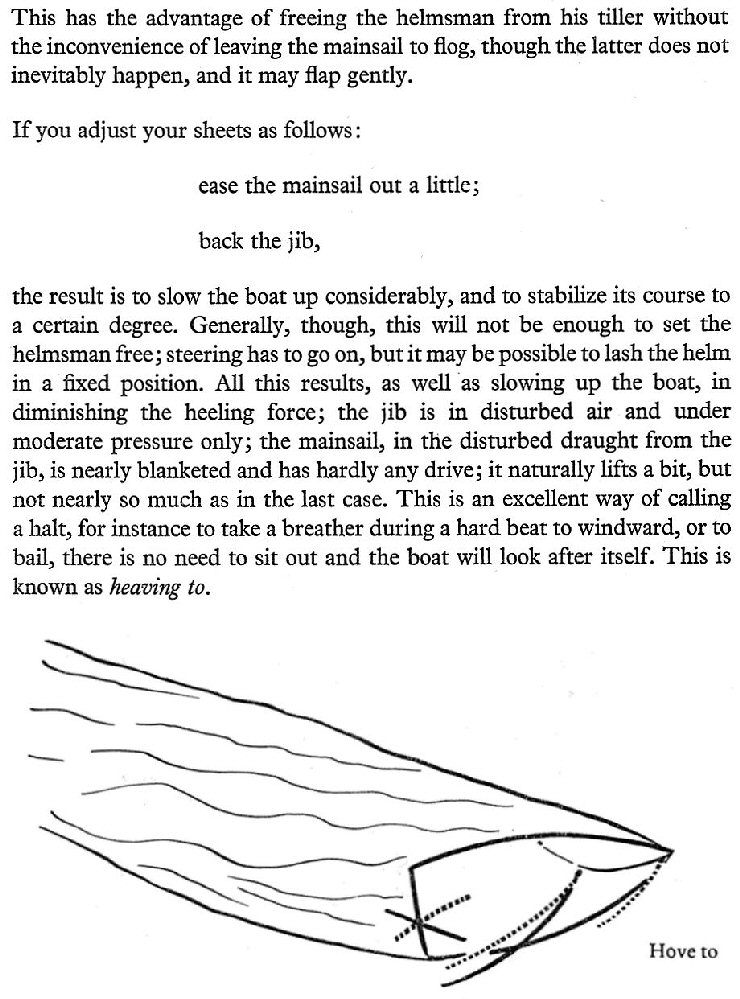| Subject:
of jib reefing and muscle boxes -----
Original Message -----
From:
Pete Haak (Mistral 788)
To: Al
Schonborn
Sent: Sunday, April 01, 2007 5:29 PM
Subject: Boat
stuff
Hi Al,
I am sure going to put your tuning
advice to good use. I can see where I have had some bad habits in
the past. Thanks for the info!
I know I've already asked you
regarding reduced head sail and I also know everyone is busy getting
ready for this sailing season but I'd also like to know as an associate
member with a Mistral which of this year's Wayfarer activities might be
appropriate for me to participate in.
Let me know when you get a chance
Thanks in advance!
Pete
Haak
Mistral
788
-----
Original Message -----
From:
Al
Schonborn
To:
Pete Haak (Mistral 788)
Sent:
Sunday, April 01, 2007 10:53 PM
Hi, Pete:
I'm happy to hear that
you're finding the materials helpful.
You are welcome to join
in everything except Nationals and the North American Championship.
US-based regattas are still iffy and at the moment you'd have to ask on
a case-by-case basis. Cruising-wise, you've already been invited to the
Rally at Killbear and will be welcome at anything else that may come
up. The Rally - July 21-27 at Killbear - would be an ideal way for you
to get acquainted with the gang but you may have trouble getting a
campsite by now. However, if you are interested, let me know and I'll
pass you on to the main organizers who can put you onto the email group
list where we can see if anyone would have ideas, e.g. campsite sharing.
Take care,
Uncle Al (W3854)
-----
Original Message -----
From:
Pete Haak Mistral 788
To: Al
Schonborn
Sent: Wednesday, April 04, 2007 7:28 PM
Hi Al,
The Rally at Killbear would have
been a good start but it conflicts with my company's annual vacation.
Not enough whiskers... I have my eye on the activities the CWA has
planned around Canada Day at the North Bay YC. From the description
of the event there will be lots of different sailing activities and
things to see and do. I will have just finished up my Champlain Lake
cruise at that time. I'll bring pictures. I hope I'm still in the mood
for more sailing by then! Any info regarding shortening head sails
would be appreciated.
Thanks,
Pete
Haak
Mistral
788
-----Original Message-----
From: Al Schonborn [mailto:uncle-al3854@cogeco.ca] Sent: maandag 16 april 2007 19:01 To: Pete Haak Cc: Ton Jaspers; Dick Harrington Subject: shortening sail Hi, Pete:
I do hope we'll see you
at North Bay!! Regarding headsail shortening, I gather this can be done
with furling gear used partially - Dick Harrington and Ton Jaspers
copied for their potential input. A cheaper option would be to sail
under main alone, especially a reefed main for better boat balance.
Cruising guys do this all the time! Of course you'd need to either
avoid getting into irons or learn how to get out of irons. Even in the
fairly windy conditions a couple of days during last year's Rally on
the St. Lawrence near Kingston, Julia and I sailed with full sail
upwind and just ragged our sails as much as it took, and did just fine.
One "leg" was a dead run home where we sailed under jib alone and that
worked a treat as always - no good for extended upwind work though!
I'll copy you in another answer I have coming up that deals with a
similar question and will give more details.
Take care,
Uncle Al (W3854)
----- Original Message ---- From: Ton Jaspers (W10445) To: Al Schonborn <uncle-al3854@cogeco.ca>; Pete Haak Cc: Dick Harrington Sent: Monday, April 16, 2007 4:48:28 PM Hi Pete, Linda, Al, Dick and others,
I think Dick uses the double headsail method
that I have seen used by many others. Both
the (storm jib and genoa are hooked on at the tack, one of the
sails is tied to the deck while the other is in use. Changing sails can
thus be done from inside the cockpit. The typical mahogany handle
bars are in a perfect location to tie the unused sail to. I
am sure Dick will tell us more about this system.
I use a roller furler, got used to it and don't
want anything else anymore. I
have just created a short essay on the subject in Dutch but I'll
translate it for you guys. Please remember that I am somewhat biased
because I sail solo quite
a lot. Sailing solo in a Wayfarer is much easier with a reliable
furler. After all, a crew of two almost has the same weight as the boat
(168 kg, heavy crew). Going out solo is almost the same as leaving 25%
of your ballast weight home (apologies to Conny). Here we go
with my translated article:
Dear Ger and Petra, It is a simple question, unfortunately the answer is a bit more complicated. First of all you need to ask if you want a device to furl away the sail altogether or a device to reef the headsail. These devices are distinctly different. 1. Furl-away systems If you only want to furl away the headsail you need a furler and a top swivel. It is not possible to reef with this equipment. The wind would unroll the sail immediately and you end up with a small part of the sail rolled up at the tack. In heavy weather, this even happened to me when the sail was fully furled away. As usual, this only happens when you least need it, when the going gets tough. I have learned this lesson the hard way, and sail with a reefing furler ever since. Another problem with the furl-away system is that you need something to keep the forestay out of the sail. With full tension on the jib halyard, the stay is slack and is easily rolled into the headsail. The stay needs to be kept away from the headsail luff, with some iron wire or a plastic triangle or a disc (a CD) and some bungee. Despite this arrangement the stay still gets caught sometimes.Unless you get the Harken High Load Roller, you also need a muscle box or cascade pulley system that enables you to take the tension off the rig while sailing. With the exception of the Harken High Load furler most others will not turn under load. Altogether it is a simple, cheap but far from perfect system. I have found a page that shows most of the existing furler systems on one page: The Harken High Load is HK164 and HK165 (As a set they are called HK453 and possibly a little less expensive). I used to have the SeaSure furler shown on that page but it never worked unless I took the rig tension off before operating it. 2. Reefing systems. The difference between a furler and a reefing furler is a stiff tube between the furler and the top swivel. The head sail is connected to this tube, usually in the same way as your main to the mast. Because of the stiff tube the swivel and the sail cannot turn independent from the furler. A second difference is that the stay goes through the tube and can't be caught by the sail when it is furled. The down side of this arrangement is that the stay needs to turn with the sail and the bearings need to be very strong as they do not only take the load from the sail (rig tension) but also are part of the safety system (the stay). They must be so strong that they are the last part that fails when all hell breaks loose. This is one of the reasons these systems are significantly more expensive then simple furl-away furlers. Finally there is a safety wire parallel to the halyard. The safety wire keeps the mast up when the halyard breaks or is accidentally loosened. The stay inside the furler tube is in my case 5 mm thick, hence it is reasonable to expect that to be the last part to break A standard Wayfarer stay is only 3 mm thick. There is a drawback with this arrangement; the safety wire requires the system to be set together with the mast. In my case I have the sail already in but is would be easy to hoist the sail after the mast is stepped. To protect the headsail (I don't take it off) I had a cover made that closes around the sail in to a tube using Velcro. The tube is hoisted with the spi-halyard.I have seen four different reefing solutions that I shall describe briefly. There is a system by Rob Harland from the UK that is basically a Harken High load system completed with a stiff tube (tyleen tube?) that is cut open length-wise and worked over the luff of the headsail from furler to swivel. People that have it are satisfied with it, but have seen that it still torques a lot and it looks awful. The issue with the forestay getting caught still remains. The only real advantage IMHO is that it is cheap. A far better system is available from Holman (who took it over from Jack Holt). It is a round aluminium tube that is cut open. Because it is just that, it still torques a lot in comparison to an aluminium profile with a separate sail groove. The furling drum is ugly plastic (grey PVC) and rather large. The stay runs through the pipe. I think it looks ugly on a Wayfarer but it serves its purpose. Users are very satisfied with it. One step up is a system by Plastimo. Actually it is designed for a small yacht. I have seen it used on a Wayfarer once and I don't like it. It is almost as expensive as the next one, it looks ugly. There is a lot of plastic used, especially on the drum that is over-sized in comparison to a Wayfarer bow. For that kind of money you are much better of with the next system. A system specially developed by Bartels GMBH in cooperation with yours truly (no discounts, shares or profits for me) (Al's note: click here for details). It is the Rolls-Royce among the Wayfarer furlers. Made solely of stainless steel and aluminium with German precision. The tube is a true drop-shape aluminium sailing profile with a separate sail groove. The furler, the swivel and all bearings (three in the swivel and three in the furler) are stainless steel. The system is designed to take a load about five times the standard design load of a Wayfarer. The tube is only 16 mm in diameter (widest measurement) and the drum has about the same modest dimensions as the Harken furler. All dimensions are fitting for a boat the size of a Wayfarer. It is the most expensive system available, but it works with absolute reliability and has only one drawback, the aforementioned safety line that requires it to be set together with the mast (The Holman system has a safety line too). I took the proto-type to Pinell & Bax (UK) who made a special sail for it. They compensated the higher tack position. The Genoa touches the deck despite the tack being above the drum. Next they added an asymmetric strip of foam to the luff and cut the sail a little less deep to ensure a good sail shape in a reefed position. Then I had Ian Porter rig it to the boat. The results will be reported back to Bartels as soon as I find the time. Bartels has promised to create a package and make it available through their web-site. Once this is done, all the world can mail order the system from them and the special sail from P&B who have saved the design in their computers for all of us. There are some pictures of my furler on the Yahoo Wayfarer group (file section). And it may be visible on the pictures from Dick Harrington's rally report. Some useful links: Simple furlers:
Reef systems:
Pinnell & Bax sail makers: http://www.pinbax.com/ From
a friend, I got this link: http://www.top-reff.de/ I don't
know these guys but their web site looks impressive. Best wishes, Ton Jaspers (W10445 - Swiebertje) -----
Original Message -----
From:
Richard Harrington
To:
Ton Jaspers ; Al Schonborn ; Pete Haak
Sent:
Tuesday, April 17, 2007 12:48 AM
Greetings,
all:
It
is certainly quite difficult following Ton. (Ton, your fabulous
explanation of the different rolling furling and reefing options
is one of the best I've seen. I'm going to make sure I keep
this in my files.) Margie and I enjoyed the pleasure of
sailing Ton's Wayfarer Swiebertje while
in Holland and I can attest to the excellent performance of his Bartels
system. It is foolproof and can be easily operated by any
amateur. If you really want to please your wife, girl
friend, or whomever, and you have the money, that's the way to go.
On
the other hand, let's assume that you have no
money to spend but by some accident of fate have acquired a small jib
(from some other dinghy type?) which is about half the size
of the genoa. In very windy conditions, that small jib will
come in handy as it will reduce sail area while helping to balance the
boat and continuing to maintain a slot for the mainsail
(better pointing ability). [A couple of years ago up in Maine,
Tom Graefe and I ended up one day with the unusual combination of
a double-reefed mainsail along with the small jib. The
boat exhibited just a wee bit of lee helm.] As Ton mentioned, if
it appears the small jib may be wanted (or vise versa with respect
to the genoa) hank both sails onto the tack fitting (I use a quick
release shackle) and tie off the unused sail. Here I need to tell
you that tying down the extra sail isn't all that easy, as
waves coming over the bow and across the deck very quickly want
to pull the sail overboard. Tying to the deck handle is
good but you also need to bring the top portion of the sail into the
cockpit and keep everything taut. But that is just the start of
things.
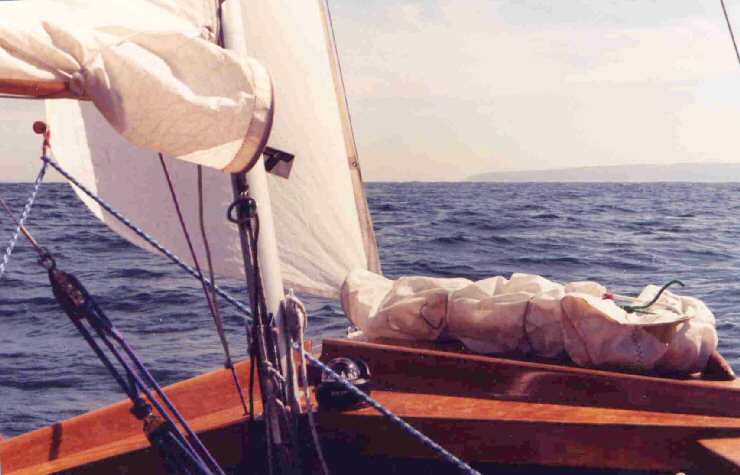 Two
other elements that need addressing when changing headsails on the fly,
are releasing the halyard, and switching the jib sheets to the new
sail. Switching jib sheets first. I use the ball
and loop
system which is easy and fast and requires no tying or changing of
sheets (see photo above).
Releasing the halyard. Being an ex-racer, I'm obsessed
with having a jib luff that does not sag too much (modern sails
are cut for that). So, for many years, I continued to use my
racing set-up with the wire halyard and the loop
that slipped over a hook on the magic box. But when
things got dicey, there was always the question, can I muster the
arm strength to get this loop off of that damn hook. There were
times when it was a close call. Finally, on one cruise, the wire
broke and I was forced to replace it with a rope halyard. It was
then that I developed my present system of using the magic
box on a rope halyard that is cleated at the mast. Now all I
have to do is uncleat the rope and down comes the jib.
It works like a charm. Presently, I can switch jibs in less
than two minutes singlehanded under any conditions. I
took photos a while back that I have yet
to load into the computer. If anyone
is interested, I can do that and send them.
DICK
----- Original Message ---- From: Pete Haak (Mistral 788) To: Richard Harrington ; Ton Jaspers; Al Schonborn Sent: Tuesday, April 24, 2007 4:22:43 PM Hello Dick,
Pictures of your magic box
system would be quite appreciated. I will be singlehanding during my
Lake Champlain cruise and I have found a smallish jib to use when I'm
reefed when things get heavy as they often do on that lake. The
southwesterlies can really get up in the late afternoon. A proven
method of changing headsails safely while underway would be most
welcome indeed!
Thanks very much in advance!
Pete
Haak
Mistral
778
-----Original Message-----
From: Richard Harrington Sent: woensdag 25 april 2007 4:26 To: Pete Haak; Ton Jaspers; Al Schonborn Okay,
Pete. I'm digging into the pics right now and will get back to
you. I'm thinking that it may also require a diagram in order to
pull it all together. It looks complicated but once you've got it
together the rig works like a charm. I've been kicking myself for
not doing this sooner. It wasn't until the wire halyard broke
while I was on the Chesapeake and wasn't able to get a replacement that
I got the inspiration. Just looking at the sag in the jib luff as
a result of using the rope halyard with a tension adjuster drove me
nuts
right away.
DICK
-----
Original Message -----
From:
Ton Jaspers
To: 'Richard Harrington' ; 'Pete Haak' ; 'Al
Schonborn'
Sent: Wednesday, April 25, 2007 2:40 PM
Below are a few pics of the muscle box set-up I use on my W. Mind you a muscle box has a lot of sheaves and those cause friction. A cascade system has much less friction and is much cheaper. Despite that, I have yet again a muscle box on my new boat, because I like the neatness of it, no ropes and blocks all over the place. The cascade system used on most new English boats today is very similar to the cascade kicker shown on the WIT. The only difference is that it lies flat around the CB on top of the case (on both sides of the CB). And it does not need steel wire nor steel wire blocks. Harken does not make their very fine muscle boxes any more. I got mine from Sprenger (Germany). Sprenger have dealers all over the World but you can also mail order direct from them: http://www.sprenger.de/hs/ The muscle box is at the top of page 94 of the catalogue (10MB PDF, alert!) http://www.sprenger.de/hs/abt_boot/produkte/boot_05gesamt.pdf I use the biggest one: 36618 0095 53. If you decide to order it, don't forget to order the hook as well: 13218 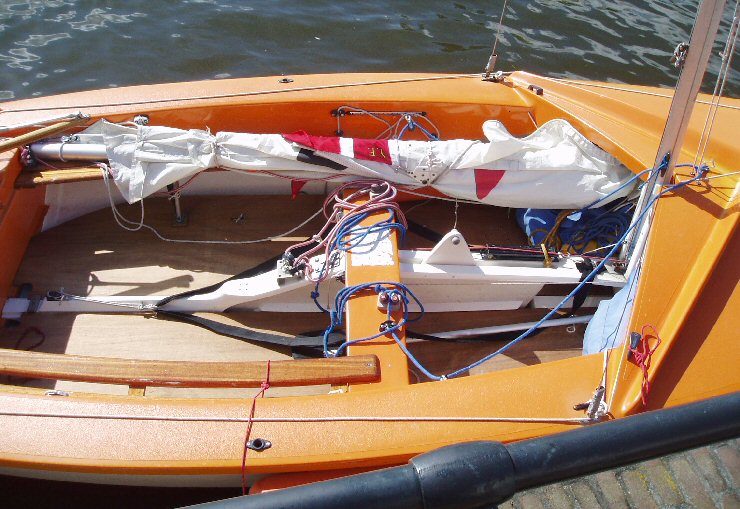 muscle box on port side of centreboard box just forward of the board itself on Ton's old Wayfarer 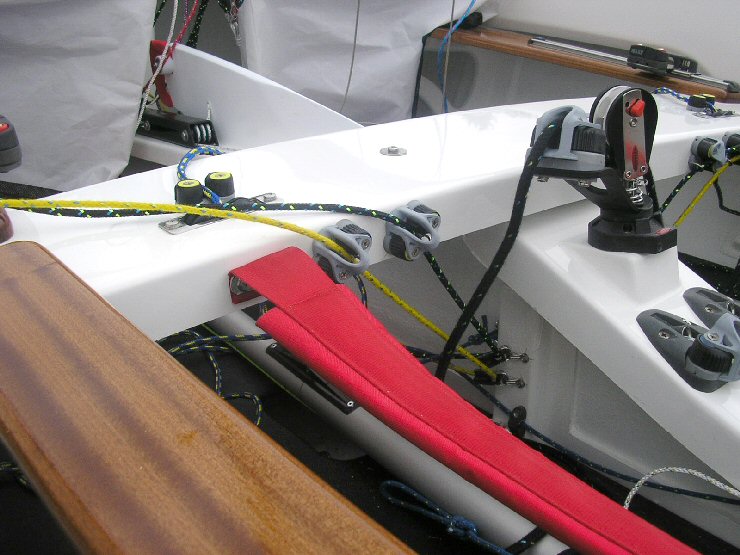 The new set-up on this Porter Brothers beauty is the Rolls Royce of set-ups: The white speckled line used to adjust tension leads aft along the port side of the board, goes under the thwart and ends up ... 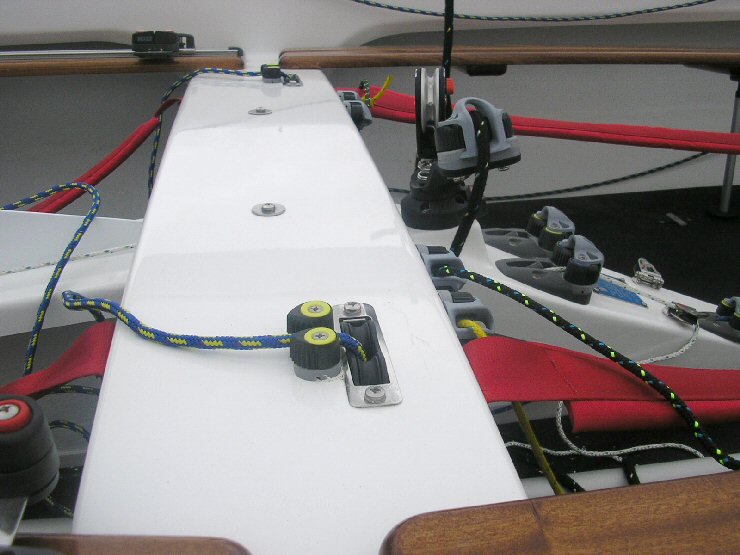 ... emerging from underneath the centreboard box cap just aft of the thwart where white speckled rope passes through a cam cleat with ... 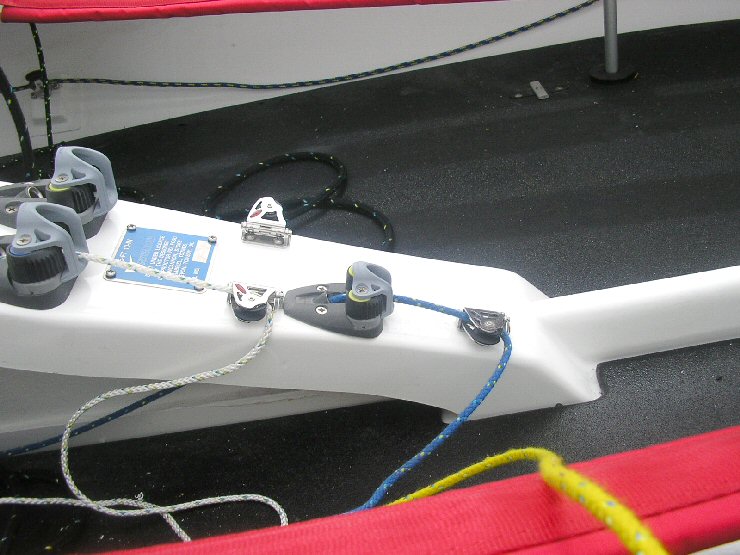 ... the grey housing that keeps the line
centred above the cams. That last little touch is a block that stays
aligned but can swing 180° to either side, thus enabling the hiked
out helm to adjust from either side of the boat. As I said, the Rolls
Royce of magic box set-ups.
My muscle box is attached to the top of the CB box with four self-tapping screws, slightly slanted relative to the centre line, in such a way that it follows the straight line from the mast foot to the cleat. The cleat arrangement consists of a through deck bushing (with SS insert) in front of the thwart, just above the CB case. The control line goes through it, passes under the thwart and comes up through a through-deck cleat base by Holt (number HA4771). On that base is a Ronstan carbon cleat (RF5010). I like those better then the Holt Allen ones, Harken Carbo is perhaps even better but so darn expensive over here (Europe). The cleat is completed by a Front Fairlead (RF5015). Behind the cleat is a Ronstan "mini" series 30 pivot lead block (Nr RF30174). The flip block ensures the control line runs through the cleat when the line is pulled. To release it you just grab the control line between the flip block and the cleat. After hoisting the Genoa, the SS-halyard goes over the hook of the muscle box. I then give a good yank on the control line et voilà, lots of rig tension to enjoy. Hope this helps, Cheers, Ton |
